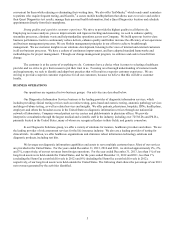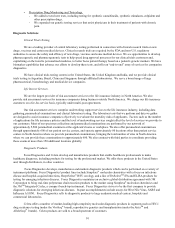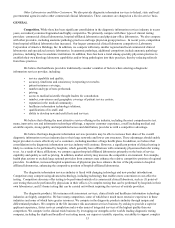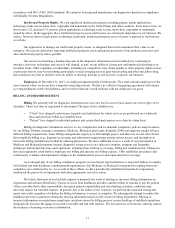Quest Diagnostics 2013 Annual Report Download - page 18
Download and view the complete annual report
Please find page 18 of the 2013 Quest Diagnostics annual report below. You can navigate through the pages in the report by either clicking on the pages listed below, or by using the keyword search tool below to find specific information within the annual report.14
its customers. A member of a health plan may choose to access a non-contracted provider that is a member of a complementary
network; if so, the provider will be reimbursed at a rate negotiated by the complementary network.
We attempt to strengthen our relationships with health plans and increase the volume of our services for their members
by offering to health plans services and programs that leverage our Company's expertise and resources, including our superior
access, extensive test menu, medical staff, data, and wellness and disease management capabilities.
Physicians. Physicians, including both primary care physicians and specialists, requiring diagnostic information
services for patients are the primary referral source of our services. Physicians determine which laboratory to recommend or
use based on a variety of factors, including: service; patient access and convenience, including participation in a health plan
network; quality; price; and depth and breadth of test and service offering.
Hospitals. Hospitals generally maintain an on-site laboratory to perform the significant majority of clinical testing for
their patients and refer less frequently needed and highly specialized procedures to outside service providers, which typically
charge the hospitals on a negotiated fee-for-service basis. Fee schedules for hospital reference testing services often are
negotiated on behalf of hospitals by group purchasing organizations. We provide services to hospitals throughout the United
States, including esoteric testing services, in some cases helping manage their laboratories and serving as the medical directors
of the hospital's histology or clinical laboratory. We believe that we are the industry's leader in servicing hospitals. Hospitals
generally continue to look for ways to fully utilize their existing laboratory capacity: they perform testing their patients need
and may compete with non-hospital providers for outreach (non-hospital patients) testing. Continuing to obtain referrals from
hospitals depends on our ability to provide high quality services that are more cost-effective than if the hospitals were to
perform the services themselves.
Hospitals may seek to leverage their relationships with community physicians by encouraging the physicians to send
their outreach testing to the hospital's laboratory. In addition, hospitals that own physician practices may require the practices to
refer testing to the hospital's affiliated laboratory. In recent years, there has been a trend of hospitals acquiring physician
practices, and as a result, an increased percentage of physician practices are owned by hospitals. Increased hospital
acquisitions of physician practices enhance physician ties to hospital-affiliated laboratories and may strengthen their
competitive position. Hospitals can have greater leverage with health insurers than do commercial clinical laboratories,
particularly hospitals that have a significant market share; hospitals thus have been frequently able to negotiate higher
reimbursement rates with health insurance plans than commercial clinical laboratories for comparable clinical testing services.
In light of continued pressure to reduce systemic healthcare costs, hospitals may change their approach to providing clinical
testing services. We believe that our combination of services, including full-service, bi-coastal esoteric testing capabilities,
medical and scientific professionals available for consultation, connectivity solutions, strong focus on quality and dedicated
sales and service professionals has positioned us to be an attractive partner for hospitals, offering a full range of strategic
relationships.
We also have joint venture arrangements with leading IDNs in several metropolitan areas. These joint venture
arrangements, which provide diagnostic information services for affiliated hospitals as well as for unaffiliated physicians and
other local healthcare providers, serve as our principal facilities in their service areas. Typically, we have either a majority
ownership interest in, or day-to-day management responsibilities for, our joint venture relationships.
IDNs. An IDN is a network of providers and facilities working together in providing or arranging for the provision of
healthcare. With the passage of 2010 federal healthcare reform legislation, IDNs are increasing in number and becoming more
important constituents in delivering healthcare services. IDNs may exercise operational and financial control over providers
across the continuum of care. IDNs also may function as a payer. Thus, IDNs may be able to manage the health of a
population group within a defined geography, and also may be able to influence the cost and quality of healthcare delivery, for
example through owned entities and through ancillary services. IDNs actively are considering bundled payment models for
services that they are purchasing, like diagnostic information services. The impact of IDNs on the provision of healthcare
services to date has varied. We are actively engaging with IDNs to demonstrate the value that our services can provide to them.
Employers. Employers use tests for drugs of abuse to determine an individual's employability and his or her “fitness
for duty.” Companies with high employee turnover, safety conscious environments or regulatory testing requirements provide
the highest volumes of testing. Factors such as the general economy and job market can impact the utilization of drugs-of-abuse
testing. We seek to grow our employer volumes through offering new and innovative programs to help companies with their
goal of maintaining a safe and productive workplace. We also offer employers our Blueprint for Wellness® program, providing
wellness screening and analytic services to help employers and their employees manage healthcare costs and capitalize on
trends in personalized health.
























